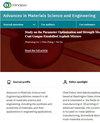用二氧化钛和二氧化钼增强的铜基复合材料的干滑动磨损行为
4区 材料科学
Q2 Engineering
引用次数: 0
摘要
本文论述了铜基复合材料的特性。铜为汽车和航空航天工业做出了贡献。铜的摩擦学性能并不令人满意,这可能是由于在生产铜基复合材料的过程中对其性能进行了广泛的研究。通过增强二氧化钛(TiO2)和二硫化钼(MoS2)制备了铜基混合复合材料,以提高铜复合材料的磨损和机械性能。通过粉末冶金工艺制备了三个试样,分别为 Cu + 5wt.% TiO2、Cu + 5wt.% TiO2 + 2wt.% MoS2 和 Cu + 5wt.% TiO2 + 4wt.% MoS2。利用 X 射线衍射 (XRD) 分析法对试样进行了冶金分析,结果证实了试样中铜、二氧化钛和二氧化锰颗粒的存在和分布。试样的磨损率与滑动速度、载荷和 MoS2 含量有关。统计分析和田口分析突出了材料磨损率的影响参数。利用 DoE 建立了线性回归方程来预测磨损率。通过分析,确定了滑动速度为 3 m/s、载荷为 30 N、MoS2 的添加量为 4% 的最佳参数,从而使磨损率最小。使用扫描电子显微镜技术对磨损机制进行了分析,以揭示粘附、分层和氧化现象。本文章由计算机程序翻译,如有差异,请以英文原文为准。
Dry Sliding Wear Behavior of Copper Matrix Composites Enhanced with TiO2 and MoS2 Hybrids
The paper deals with the properties of copper-based composites. Copper is contributing to the field of automobiles and aerospace industries. The tribological properties of copper are not found to be satisfactory, which may be attributed to the support of producing copper matrix composites with extensive investigations into their properties. Coper-based hybrid composites were fabricated by reinforcing titanium dioxide (TiO2) and molybdenum disulphide (MoS2) to enhance the wear and mechanical properties of copper composites. Three specimens were prepared by powder metallurgy process with the designations of Cu + 5wt.%TiO2, Cu + 5wt.%TiO2 + 2wt.% MoS2, and Cu + 5wt.% TiO2 + 4wt.% MoS2. The metallurgical analysis was done on the specimens using X-ray diffraction (XRD) analysis which confirms the presence and distribution of Cu, TiO2, and MoS2 particles in the specimens. The wear rate was studied on the specimens concerning the sliding velocity, load, and MoS2 content. The statistical analysis and Taguchi analysis highlight the influencing parameters on the wear rate of the material. Linear regression equations were developed to predict the wear rate using DoE. Through this analysis, the sliding velocity of 3 m/s, a load of 30 N, and a 4% addition of MoS2 were identified as the optimum parameters for the minimal wear rate. The wear mechanism was analyzed using scanning electron microscopy techniques to reveal the adhesion, delamination, and oxidation.
求助全文
通过发布文献求助,成功后即可免费获取论文全文。
去求助
来源期刊

Advances in Materials Science and Engineering
Materials Science-General Materials Science
CiteScore
3.30
自引率
0.00%
发文量
0
审稿时长
4-8 weeks
期刊介绍:
Advances in Materials Science and Engineering is a broad scope journal that publishes articles in all areas of materials science and engineering including, but not limited to:
-Chemistry and fundamental properties of matter
-Material synthesis, fabrication, manufacture, and processing
-Magnetic, electrical, thermal, and optical properties of materials
-Strength, durability, and mechanical behaviour of materials
-Consideration of materials in structural design, modelling, and engineering
-Green and renewable materials, and consideration of materials’ life cycles
-Materials in specialist applications (such as medicine, energy, aerospace, and nanotechnology)
 求助内容:
求助内容: 应助结果提醒方式:
应助结果提醒方式:


